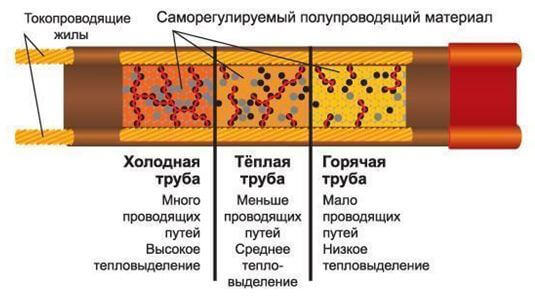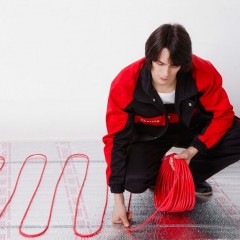How is a self-regulating heating cable arranged?
Design Features
How is a self-regulating conductor arranged? The design consists of certain parts, namely:
- Two copper conductors. They provide voltage along the entire length of the wire.
- Heated conductive matrix. This is the main device in the design. The use of such a matrix allows you to adjust and heat the element itself. Each of its parts is connected between two wires in parallel, thus connecting to an electrical circuit.
- Insulation layer. For a greater degree of thermal protection, the electrical structure is wrapped in several layers of insulation.
- Protective shielding braid. It is made of metal and its use is necessary to protect against various mechanical and electromagnetic influences. Grounding is also applied to this braid.
- Outer shell. Such a protective coating protects the structure from mechanical damage.
Thanks to this simple design, the self-regulating heating cable becomes resistant to various damage and is able to provide a high and long service life.
Operating principle
The principle of operation of such a product is a bit like the work of a resistive conductor. The self-regulating heating cable works on the basis of the properties of the electric current conductor: when it is heated, the resistance increases. The higher it is, the lower the current strength and, accordingly, less power spent.
The principle of operation of the polymer matrix in this case is as follows: when the temperature decreases in any part of the matrix, the current conductivity increases, and as a result, the heating element heats up more. Thanks to this, the temperature can be adjusted without the use of various temperature controllers. Thus, thermoregulation is achieved.
For example, the principle of operation in a certain section of the wiring, which is located in a cold place, is as follows: it has less resistance, but a significant current flows through the matrix here, which significantly heats the device. Where the pipe section is warm, the resistance will be large, which means that the flowing current is less. Therefore, when a self-regulating heating conductor is connected to the freezing water pipe, it starts to work at full strength, and when the pipe starts to warm up, the power of the device will increase. About, how to make water heating pipes, we told in the corresponding article.
The principle of operation of such a product makes it possible to obtain:
- reliable device that will last for many years;
- use of the product in all circumstances and conditions.
The video reviews below clearly show how this type of conductor works and what it consists of:
Application area
A self-regulating heating cable is used when heating a water supply system, cornice, floor or roof, as well as other elements where it is necessary to prevent freezing of water. The principle of operation of such a cord allows us to distinguish three main areas of application of the product:
- for private needs (heating of the sewerage or water supply system);
- for commercial organizations (heating pipes, fire extinguishing systems);
- in the industry (for work in the conditions of the increased danger).
It is possible to understand which self-regulating heating cable belongs to a certain sphere according to the specified service life and the matrix material with a degree of protection of the material for insulation.
Advantages and disadvantages
Like any product, a self-regulating heating cable has its advantages and disadvantages. In addition to reliability and simplicity in design, the heating conductor has the following advantages:
- the entire length is heated evenly and uniformly;
- the self-regulating heating element is steady against voltage drops;
- energy savings, with a sufficiently high power consumption of electric energy will be relatively small;
- such a design is considered safer, even with overlap it is reliably protected from overheating;
- almost no need for maintenance;
- no length limit.
The self-regulating heating conductor also has its drawbacks. The disadvantages of this design include:
- relatively high cost per meter of products;
- the cable is produced in large volumes in coils and in most cases there are no factory couplings and glands for connection, as well as pipes for insulation (all this will need to be purchased on your own).
So we examined the device and the principle of operation of a self-regulating heating cable. We hope you now understand how this heating conductor works and where it can be used!
It will be interesting to read:









